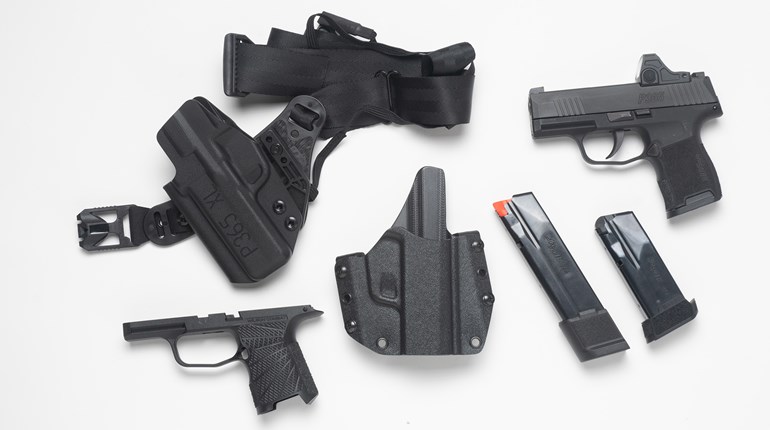
Headquartered in the hills of northern Italy, Beretta is the world’s oldest firearm company. The company has been making guns for longer (much longer) than there has been a United States of America, and in that time, it has learned a thing or two about making a high-quality firearm.
Beretta’s history with pistols began during World War I with the Model 15, created for the Italian Army, and continued over the following decades with classic designs such as the iconic Beretta 92. For most of the 80’s and 90’s, the Beretta 92 defined what a pistol should be. Adopted as the M9 pistol, it replaced another iconic pistol, the M1911 chambered in .45 ACP as the standard sidearm of the U.S. Military. The Model 92 also made dozens of appearances in the movies of the time, with Chow Yun Fat weilding a pair of 92’s in “A Better Tomorrow” to Mel Gibson using one in “Lethal Weapon” to Bruce Willis in “Die Hard,” the Beretta 92 should probably have its own star on the Hollywood Walk of Fame.
Times change, however. The Model 92 is made primarily of metal, and modern polymers are now the standard for today's pistols. The double action / single action trigger on the 92 can be a bit hard to overcome, leading to the popularity of striker-fired actions with a consistent trigger pull. The U.S. military (and others) saw the advantages of all these features, and in 2017, the Beretta M9 was replaced by the polymer-frame, striker-fired M17/M18 pistols produced by SIG Sauer.
Beretta was not content to sit on the sidelines, though, and in 2017 came out with the APX line of pistols which embrace the polymer-frame, striker fired approach to defensive pistols. The original APX lineup is being revamped and updated with the APX A1 series, with improved ergonomics and better triggers. We recently reviewed the first model in the series, the APX A1 Carry, and now Beretta has come out with a larger pistol, the APX A1 Full Size.

The APX A1 Full Size is, as the name implies, a full-sized service pistol that is ideally suited for military or law enforcement use, but is also very suitable for an armed citizen for concealed carry or home defense. It is a 9mm pistol that ships with two 17-round magazines, with 10-round magazines available where required by current law. Special attention has been paid to ergonomics with the A1 update, and it shows in this gun. The controls are right where you would expect them to be, and there are serrations on the front and rear of the slide for easy gun manipulations. On top of this, both the slide release and the magazine release can be moved to the other side of the pistol for southpaw shooters.
Speaking of the slide, while the toned-down serrations might first grab your attention, the slide also comes cut from the factory for mounting red dots via any one of a number of adapter plates that can be ordered separately. There is also a tritium-enhanced white dot sight up front and a blacked-out rear sight for those who prefer iron sights.

The frame of the APX A1 Full Size also has stippling on the grip and on the side of the frame where your trigger finger might rest when not on the trigger. The gun ships with two interchangeable backstraps, although I found the standard size backstrap worked just fine for my (small-ish) hands. The trigger guard is undercut slightly, allowing you to snug your hands up higher on the gun for more recoil control.
And let’s talk about the trigger for just a bit. One of the knocks against striker-fired pistols is their trigger feel, with words like “feels like a staple gun” being thrown around by various detractors. However, the trigger on the APX A1 Full Size is terrific. There is about an eighth of an inch of slack and another eighth of an inch of takeup. The trigger on my test pistol broke at just under five pounds, with a nice, very distinct wall with a clean break and zero overtravel and a very noticeable reset.
On the range, the gun was very easy to shoot, with a nice hefty feel that pointed well. The trigger was very easy to run in comparison to other “match” triggers on similar guns, with a short amount of travel and a clear, distinct break. There were no hiccups while manipulating the gun and performing basic tasks such as reholstering and changing out magazines, and everything ran just like you’d expect a well-made modern service pistol to run.
We shot over 260 rounds of ammo in our testing without any malfunctions, and performed an accuracy test at 15 yards with three types of ammo: Winchester 147 grain FMJ practice ammo, Remington 147 grain HTP JHP defensive ammo, and Federal 115 grain FM practice ammo, with the following results:
|
Ammunition Tested* |
Average Velocity (FPS) |
Max. Velocity (FPS) |
Min Velocity (FPS) |
Group Size (Inches) |
|
Winchester 147 Gr FMJ |
958 |
981 |
937 |
1.5 |
|
Remington 147 gr HTP JHP |
918 |
963 |
894 |
1.78 |
|
Federal 115 gr FMJ |
1149 |
1185 |
1126 |
1.6 |
*Five-shot groups shot from 15 yards from a rest and measured from middles of furthest bullet holes using a caliper.
Overall, I found the APX A1 Full Size to be an excellent defensive pistol. Its larger size means you’ll have to pay some careful attention to holster type, carry position and cover garment, but if you do, you’ll be rewarded with a well-made pistol that continues Beretta’s long heritage of making world-leading firearms for, and with an MSRP of $529, you won’t have to be a world leader in order to afford one.



































